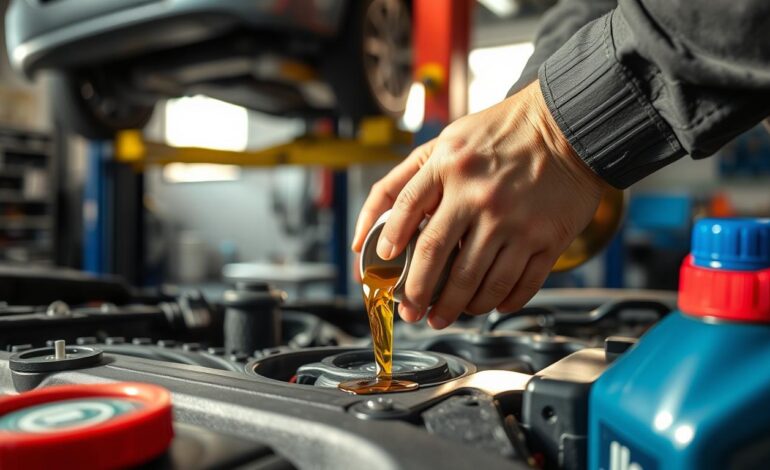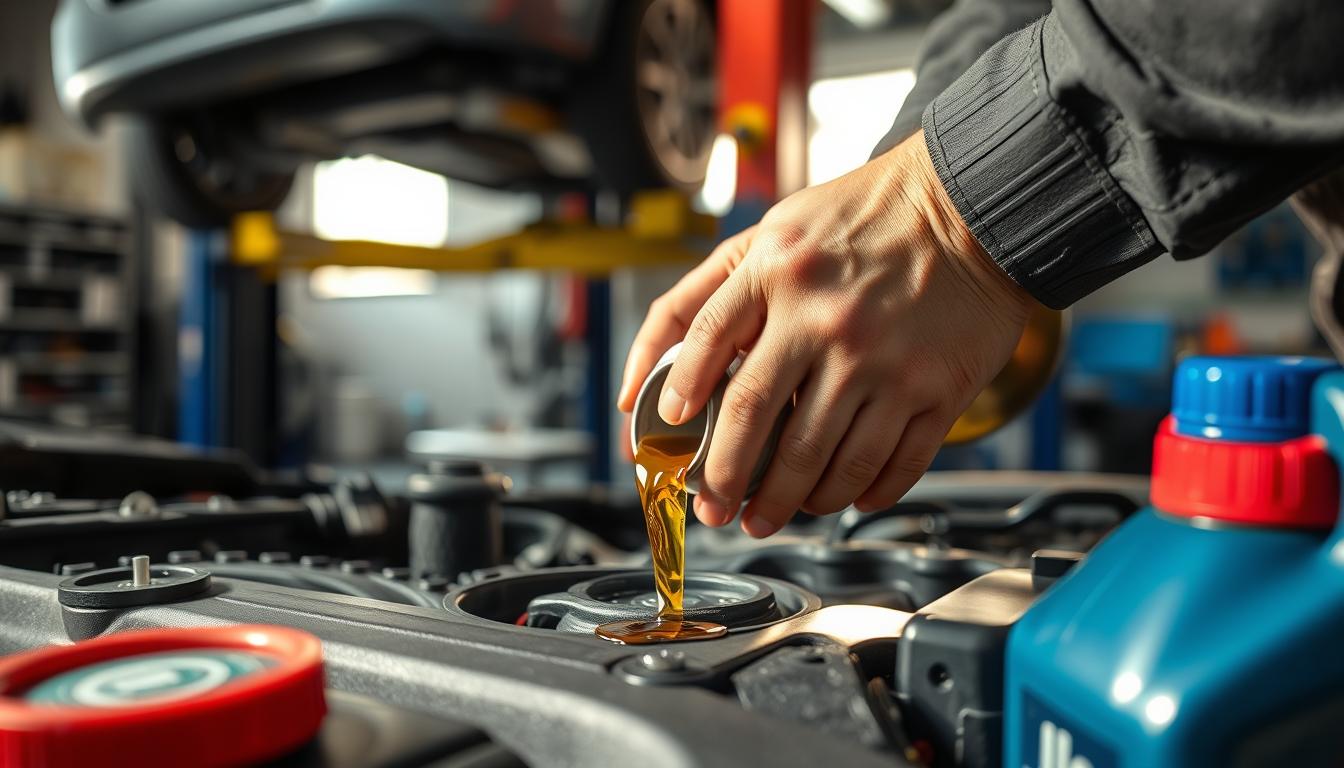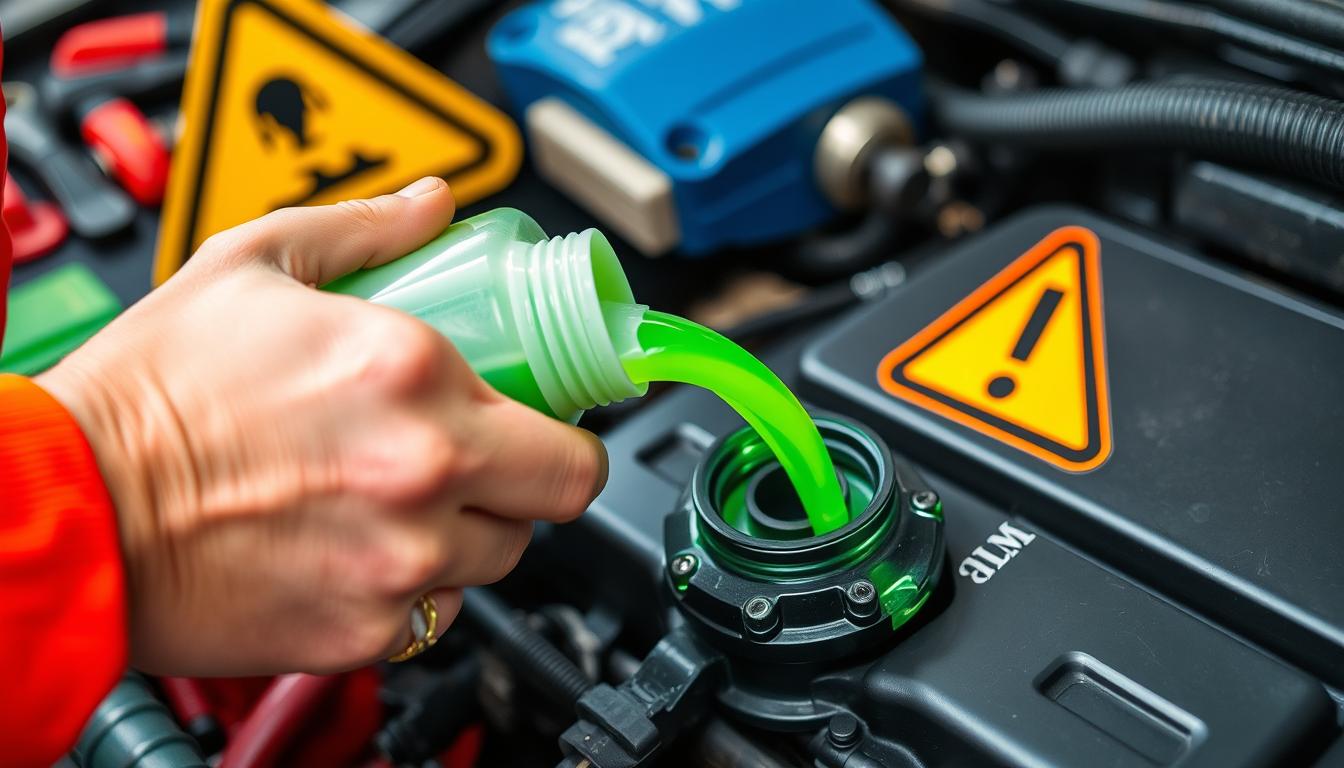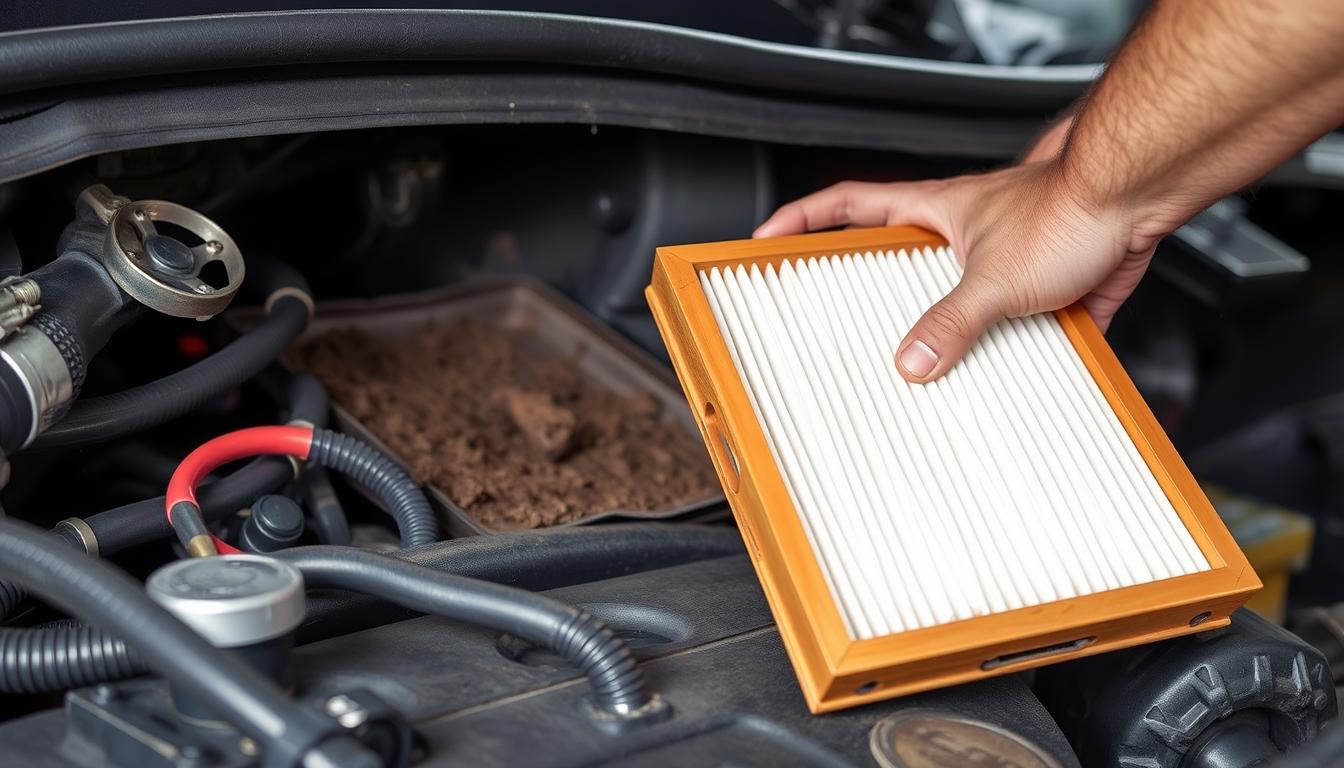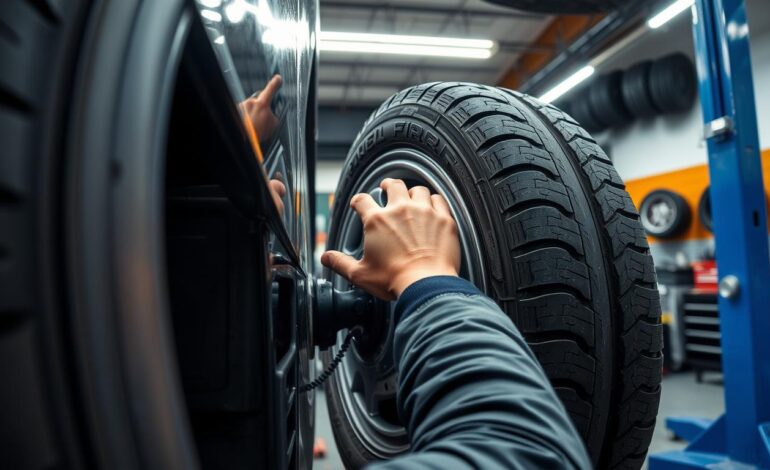
Tips for Extending the Life of Your Tires: Rotations and Balancing
Keeping your tires in good shape is key to making them last longer. Regular rotations and balancing prevent uneven wear. This also boosts fuel efficiency and improves how your car performs. Taking care of your tires is vital for a smooth ride and better vehicle performance.
Regular rotations and balancing are part of good tire care. They stop uneven wear and save fuel. By focusing on tire maintenance, you can make your tires last longer and keep your car running well.
Introduction to Tire Maintenance
Understanding tire maintenance is important for car owners. It helps extend your tires’ life and boosts your car’s performance. Rotating and balancing your tires regularly is key to avoiding uneven wear and saving fuel.
Key Takeaways
- Regular tire rotations can help extend the life of your tires
- Tire balancing is essential for preventing uneven wear
- Proper tire maintenance can improve fuel efficiency
- Tire maintenance is vital for vehicle safety
- Regular tire rotations and balancing can enhance overall vehicle performance
Understanding the Basics of Tire Maintenance
Tire maintenance is key to keeping your tires in good shape and safe on the road. Two important services are tire rotation and tire balancing. They help ensure even wear and prevent vibrations, which can cause uneven wear and lower tire performance.
Regular tire rotation moves tires to different spots to wear them evenly. This stops uneven wear, which can reduce traction and increase the risk of a blowout. Tire balancing adjusts tire weight to stop vibrations. Vibrations can cause uneven wear, leading to poor tire performance and a higher risk of a blowout.
What is Tire Rotation?
Tire rotation moves tires to different spots for even wear. The pattern depends on the vehicle type and the manufacturer’s advice.
What is Tire Balancing?
Tire balancing adjusts tire weight to stop vibrations. A balancing machine measures tire and wheel weight to find imbalances.
Why These Services Matter
Tire rotation and tire balancing are vital for tire performance and preventing uneven wear. Regular services extend tire life, improve road safety, and lower blowout risk.
| Service | Benefits |
|---|---|
| Tire Rotation | Extends tire life, promotes even wear, and reduces risk of blowout |
| Tire Balancing | Prevents vibrations, promotes even wear, and improves tire performance |
Signs Your Tires Need Attention
Regular tire maintenance is key to extend tire life and keep you safe on the road. There are clear signs that your tires need some care. Look out for uneven wear, vibrations, and if your car uses more fuel than usual.
Some common signs that your tires need attention include:
- Uneven wear patterns, such as feathering or cupping
- Vibrations while driving, which can be caused by unbalanced tires
- Reduced fuel efficiency, as underinflated tires can decrease gas mileage
- Cracks or bulges in the tire sidewall, which can lead to a blowout
By noticing these signs and keeping up with tire maintenance, you can make your tires last longer. This also saves you from expensive repairs. It’s vital to keep your tires in good shape for your safety and others on the road.
Remember, regular tire maintenance is essential for your safety and your tires’ longevity. By following these tips and staying on top of tire maintenance, you can avoid accidents and keep your car running well.
The Science Behind Tire Wear Patterns
Tire wear patterns tell a lot about how you drive and your car’s health. Knowing these patterns is key to keeping your car safe and in good shape. Tire wear patterns are shaped by your driving habits and the driving environment.
There are normal and abnormal tire wear patterns. Normal wear means your tires are wearing evenly. Abnormal wear can point to car alignment or suspension problems. Look for signs like uneven tread wear, feathered edges, and cupped tires to spot these issues.
- Uneven tread wear
- Feathered edges
- Cupped tires
These signs can come from aggressive driving, bad road conditions, or extreme weather. Knowing the science behind tire wear patterns helps you avoid abnormal wear and make your tires last longer.
By understanding how driving habits affect tire wear patterns, you can change your driving style. Regular car maintenance also helps keep your tires in top shape for safer driving.
| Tire Wear Pattern | Cause | Solution |
|---|---|---|
| Uneven tread wear | Poor alignment | Check and adjust alignment |
| Feathered edges | Improper inflation | Check and adjust tire pressure |
| Cupped tires | Worn-out suspension | Inspect and replace suspension components |
Professional Tire Rotation Services: What to Expect
Regular tire rotations are key for tire maintenance. They help your tires last longer and save fuel. Professional services offer many benefits, like better handling and safety, and lower risk of tire failure.
A professional will check your tires, wheels, and suspension. They look for wear or damage and suggest fixes or replacements. The service might also include:
- Rotation of tires to ensure even wear and extend their lifespan
- Inspection of tire pressure and adjustment as needed
- Check of wheel balance and alignment
- Visual inspection of the suspension system for any signs of wear or damage
Professional tire rotation services bring many advantages. You get safer driving, better fuel use, and longer tire life. Always pick a trusted service and get regular rotations to keep your tires in great shape.
Proper Tire Balancing Techniques
There are several ways to make sure your tires are balanced right. Tire balancing helps your tires last longer and makes your car run better. Static balancing is a common method. It measures the tire and wheel’s weight to find the balance.
Dynamic balancing is another technique used. It considers the tire’s spin and movement for a more precise balance. Both methods are key to keeping your tires balanced and preventing uneven wear.
Static Balancing
Static balancing is easy and effective. It uses a balancing machine to weigh the tire and wheel. The machine tells the technician how much weight to add for balance.
Dynamic Balancing
Dynamic balancing is more advanced. It uses a special machine that mimics the tire’s spin. This allows for a more accurate balance.
Equipment Used
For tire balancing, you need balancing machines, weights, and other tools. The tools used depend on the vehicle and balancing method. With the right equipment and techniques, technicians can balance your tires properly.
| Technique | Description |
|---|---|
| Static Balancing | A simple method that measures the weight of the tire and wheel assembly |
| Dynamic Balancing | An advanced method that simulates the tire’s rotation and movement |
DIY Tire Inspection Guidelines
Regular DIY tire inspection is key to keeping your tires in good shape. It helps spot problems early, preventing bigger issues later. You should check tire pressure, tread depth, and look for uneven wear signs.
Here are some tips for a DIY tire inspection:
- Check tire pressure at least once a month, and before long trips
- Use a tire pressure gauge to ensure accuracy
- Inspect tread depth by inserting a penny into the tire groove with Lincoln’s head facing down
- Look for signs of uneven wear, such as feathering or cupping
By following these guidelines and making DIY tire inspection a part of your routine, you can extend your tires’ life. This ensures your safety on the road.
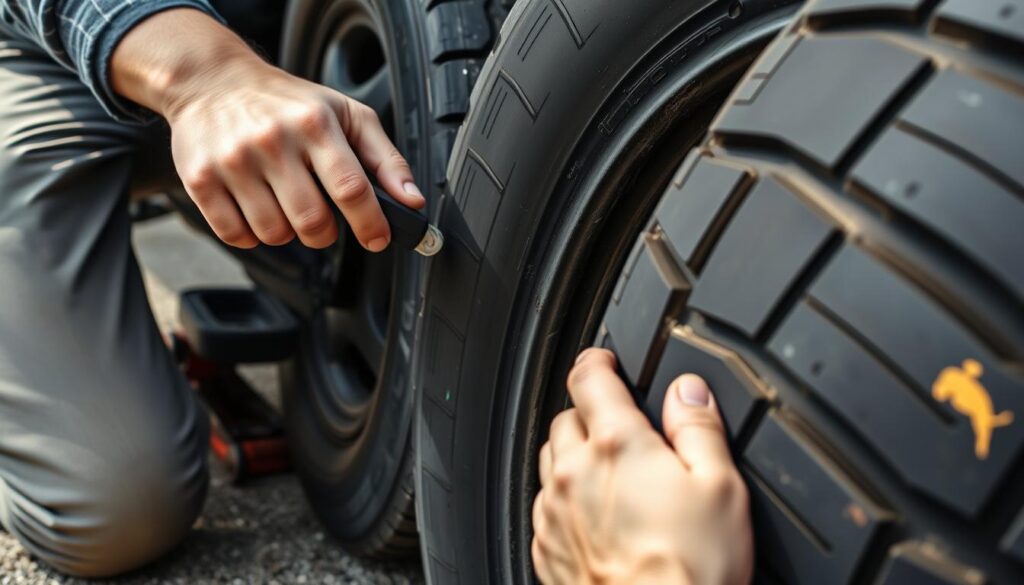
Regular inspections catch issues early, saving you time and money. Make DIY tire inspection a habit. It keeps your tires in great shape and your vehicle running smoothly.
| Tire Inspection Task | Frequency |
|---|---|
| Tire Pressure Check | Monthly |
| Tread Depth Inspection | Every 6 months |
| Uneven Wear Check | Every 3 months |
Cost Benefits of Regular Tire Maintenance
Regular tire maintenance is key to making your tires last longer and avoiding expensive fixes. By adding tire rotations and balancing to your routine, you save money. This approach can lead to big savings over time.
It also prevents costly repairs. Uneven tire wear can damage your car’s suspension and steering, leading to high repair bills. Regular maintenance reduces these risks. The main benefits include:
- Extended tire life
- Improved fuel efficiency
- Reduced risk of costly repairs
Regular maintenance also boosts your car’s performance and safety. It keeps your vehicle running smoothly and efficiently.
Long-term Savings
Regular tire care saves you money in the long run. It makes your tires last longer, reducing the need for frequent replacements. It also improves fuel efficiency, lowering fuel costs.
Preventing Expensive Repairs
Regular maintenance prevents expensive repairs. It keeps your tires balanced and rotated, avoiding suspension and steering problems. This saves you from costly repairs and keeps your car running well. Regular tire care offers many benefits, including longer tire life, better fuel efficiency, and fewer repair costs.
| Service | Cost | Frequency |
|---|---|---|
| Tire Rotation | $20-$50 | Every 5,000-8,000 miles |
| Tire Balancing | $15-$30 | Every 5,000-8,000 miles |
When to Schedule Your Next Service
To keep your tires in top shape, it’s key to have a tire maintenance schedule. This plan should follow mileage guidelines and think about the seasons. Most tire makers say to rotate your tires every 5,000 to 8,000 miles.
Here are some important things to think about for your next tire service:
- Mileage: Look at your car’s mileage and book a service when you hit the right number.
- Seasonal changes: Think about how the seasons might affect your tires. For example, you might need to put on or take off winter tires at certain times.
- Driving conditions: If you often drive in tough weather or on rough roads, you might need to get your tires checked more often.
By sticking to a tire maintenance schedule and keeping these points in mind, you can make your tires last longer. This will also keep you safe on the road. Always check your car’s manual for the best mileage guidelines and maintenance plans.
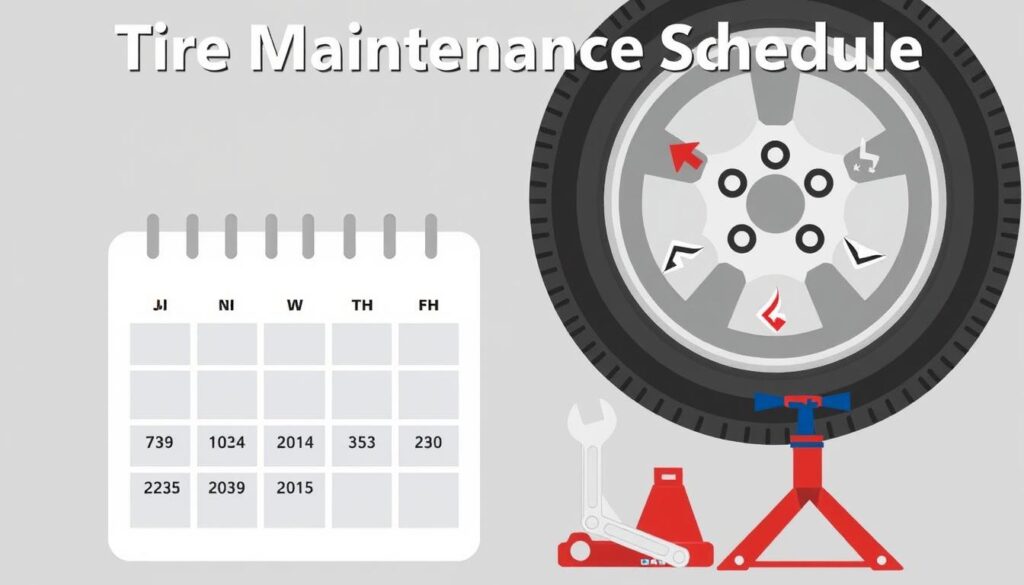
Keep up with your tire care for a better, safer drive. Talk to a pro mechanic or tire expert to make a tire maintenance schedule that fits your car and how you drive.
| Mileage | Recommended Service |
|---|---|
| 5,000 miles | Tire rotation and balancing |
| 10,000 miles | Tire inspection and pressure check |
| 15,000 miles | Tire rotation and balancing |
Conclusion: Maximizing Your Tire Investment Through Proper Care
Keeping your tires in good shape is key to making them last longer. By following the tire maintenance tips in this article, you can keep your tires running smoothly. Regular tire rotations and balancing services, along with careful inspections and quick repairs, will help a lot.
Don’t forget, taking care of your tires is not just about longevity. It also boosts your car’s fuel efficiency, handling, and safety. By focusing on tire care, you’ll enjoy a better driving experience for many years.

